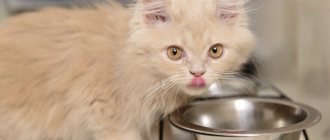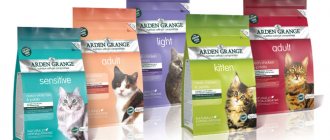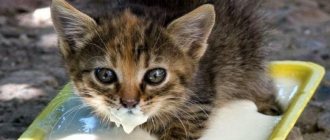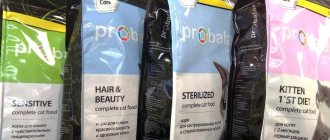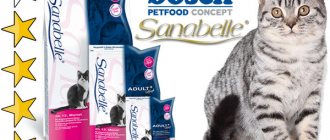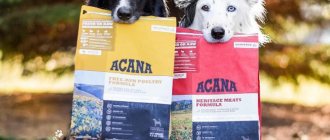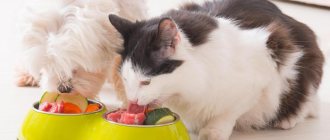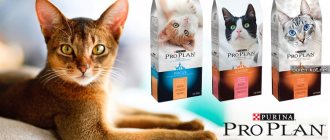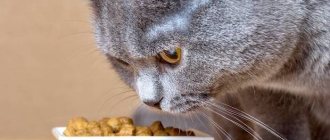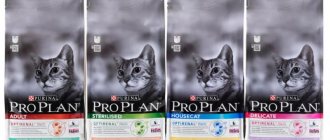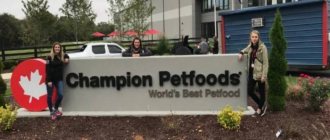Acana cat food is produced by Canadian company Champion Petfoods. We wrote about the features of production organization (“turnkey”) and the history of this company here. On our website you can reveal the composition and description of any Akana food for cats; we try to monitor the lines and updates of diets on the manufacturer’s website and make amendments in a timely manner. In Russian, the official website of Acana food for cats and dogs is acana.ru, the website of the Canadian manufacturer (in English) is championpetfoods.com.
Manufacturer information
Acana is a company that produces luxury cat food. The products are created in the small town of Marineville (Canada) by Champion PetFoods.
The history of the brand begins in 1975. A Canadian farmer named Muhlenfeld and his family owned a small pet store that sold mainly veterinary drugs. Gradually, the family began making food for cats and dogs at home. The products became in demand among the residents of the town, and Muhlenfeld decided to open a feed production. The man approached one of the leading companies producing cat food with his findings, but the management ignored his proposal.
At the same time, the residents of Marineville still bought food from natural raw materials well. This convinced Muhlenfeld that his thoughts were right to open his own industrial production. Despite the need for large investments, the family gradually managed to start producing food.
The company operates in Canada and is increasingly gaining momentum. Today, Champion PetFoods is considered one of the most progressive.
Acana food for cats
Akana is a company that offers Russians elite food for cats and dogs. Acana and Orijen are two types of food from this company. The products are manufactured in the provincial town of Morinville (Alberta, Canada). The facility where these foods are manufactured is called Champion PetFoods.
The founders of a large industrial complex are Muhlenfeld and his relatives
The history of Acana food began in 1975. A farmer named Reinhard Mühlenfeld and his family owned a small pet store. The main products were veterinary drugs, but the Mühlenfeld family had some ambitions. So they began preparing food for dogs and cats at home. The product went so well that the head of the family wanted to open a real production facility. Reinhard turned with his recipes to one of the well-known companies producing such products, but the management of the enterprise ignored the man’s desire. The investments then seemed huge, and the profits were very small.
In a small store, residents of the town were still good at sorting out food from fresh raw materials. So Muhlenfeld convinced the family that no matter how difficult it was for them, they needed to open their own industrial production. The company was founded in Mühlenfeld’s homeland, is operating and gaining momentum. Currently, most American breeders and feed evaluation committees recognize Champion PetFoods as one of the most progressive.
The manufacturer indicates that the food contains only natural products. If it is venison, then the deer certainly grew on a Canadian neighbor's farm, if it is apples, then they certainly grew in the garden on the next street, etc. Using only fresh products from reputable farmers is the basis of the company's policy. Nutritionists who develop and study the recipe for these foods do not allow the presence of harmful components in the composition. The principle of the recipes is food similar to natural food (meat, herbs, etc.).
The mission of the food manufacturer Acana contributed to the fact that this albeit expensive food reached 50 countries around the world without advertising.
Feed class and composition
Many cat owners are confident that the Acana food class is Premium. But the company’s official website classifies its products as holistic, a new class of food. In other words, such a product includes only natural ingredients:
- meat (beef, veal, lamb, rabbit);
- poultry meat;
- sea and freshwater fish;
- offal;
- vegetables are sources of fiber and carbohydrates;
- fruits and berries (help normalize the acidity of urine, reduce the risk of developing genitourinary diseases);
- seaweed (has a beneficial effect on digestion);
- medicinal herbs (promote the removal of bile, give the pet vigor).
Acana dry food is considered hypoallergenic and causes virtually no reactions in cats. Moreover, the components in the product help remove toxins from the animal’s intestines, reduce the pH of urine, and also improve digestion, since the food contains phytocomponents. The product is well absorbed and helps keep your pet's coat and skin in perfect condition.
Compound
Types of meat and offal in Acana feed:
- duck: fillet, kidneys, liver, heart;
- meat and fat, raw tripe, dried lamb cartilage;
- turkey meat, giblets;
- chicken meat, offal, fat.
Beef is not used for one simple reason: it is difficult for a cat's stomach to digest.
The plant components are as follows:
- turmeric seasoning (stimulates the secretion of bile, which is important for the cat to digest what it eats);
- marshmallow root (enveloping and anti-inflammatory effect);
- milk thistle (prevention of liver diseases);
- dried blueberries (for visual acuity);
- lavender (its aroma attracts cats);
- turnip root (contains a large amount of fiber);
- cranberry (prevention of urolithiasis);
- seaweed (contains a lot of magnesium, zinc, selenium, manganese, iodine);
- pumpkin (improves digestion);
- alfalfa (contains iron, protein, magnesium);
- legumes (green and yellow peas, green and red lentils, beans, chickpeas);
- spinach, kale, pears, apples;
- eggs.
A quarter of the composition is fruits, vegetables and herbal supplements. As we can see, the balance of fats, proteins, taurine, calcium and other important substances is maintained.
Product range
The basic range of the Acana brand consists of three types of dry food:
- Grasslands.
- Pacifica.
- Wild Prairie.
| Name | Compound | Packaging volume |
| Acana Grasslands |
|
|
| Acana Pacifica |
|
|
| Acana Wild Prairie |
|
|
On a note. The Asana company produces exclusively dry food for cats.
Many owners are interested in the question of whether Acana brand products are suitable for castrated and sterilized cats.
Veterinarian's opinion. Absolutely all Acana foods are low-carbohydrate, and therefore are a good prevention of obesity, which is often found in castrated and sterilized cats. For this reason, any of the types of food can be used to feed animals that are deprived of the opportunity to give birth.
The owner can only choose any formula, based on the tastes of his pet.
Range and features of cat food
The main range of the Acana brand consists of three types of dry food:
- Grasslands;
- Pacifica;
- Wild Prairie.
These types differ in taste, composition, calorie content and price.
Comparison table: different types of Acana food
| Name | Full listed composition | Suggested packaging volume | Calorie content | Price |
| Acana Grasslands |
|
| 4040 kcal/kg (485 kcal per glass of 250 ml/120 g). | From 1750 rubles for 1.8 kg. |
| Acana Pacifica |
|
| 4080 kcal/kg (490 kcal per glass of 250 ml/120 g). | From 1700 for 1.8 kg. |
| Acana Wild Prairie |
|
| 4100 kcal/kg (492 kcal per 250 ml/120 g glass). | From 1500 rubles for 1.8 kg. |
Photo gallery: types of Acana food
Grasslands "Acana" with lamb) packaged in green packaging - this is the most popular type of feed
Acana Pacifica is a food that cat breeders call “Fish and Pumpkin”
Wild Prairie is a variety of Akana with chicken meat.
Does Akana have treats for cats?
Akana offers its customers Orijen brand cat treats in the form of dry food. This is a higher calorie food, so it can be given only in small quantities (no more than 10% of the daily food intake). There are only five of these “goodies”:
- Fd Six Fish;
- Original Cat treats;
- Romney Lamb Cat treats;
- Tundra Cat treats;
- Wild Boar Cat treats.
Table: differences between treats
| Name | Specified composition | Calorie content | Price |
| Orijen Fd Six Fish for kittens and cats |
| 4,320 kcal/kg, or 1 kcal in each piece. | From 340 rubles for 35 g. |
| Orijen Original Cat treats |
| At least 3 calories in each piece. | From 310 rubles for 35 g. |
| Orijen Romney Lamb Cat treats |
| 5,520 kcal/kg, or 1 kcal in each piece. | From 340 rubles for 35 g. |
| Orijen Tundra Cat treats |
| At least 3 calories in each piece. | From 360 rubles for 35 g. |
| Wild Boar Cat treats |
| At least 3 calories in each piece. | From 340 rubles for 35 g. |
Photo gallery: treats for cats
All treats have different taste, composition, price and calorie content
You can buy such a treat in the same stores as everyday food.
On the right side of the package there is a pattern of crocodile skin, for this reason the packaging, for example, Romney Lamb is called a pink crocodile
Treats for cats are produced in the same packaging as the main types of food.
The word treats is always written on the treat package.
Orijen series food
Some call the Orijen brand a separate line of Acana food, but this is not entirely true. Yes, in Russia the representative office of a Canadian company is, which offers both products. But these are different foods, although they are made by the same manufacturer. So, Orijen for cats comes in several types:
- Cat & Kitten
- Fit&Trim;
- Six Fish;
- Tundra.
These foods differ from Akana mainly in their composition:
- Meat and meat products: in Orijen it is up to 85%, and in Akana it is up to 75–80%.
- Protein: Acana contains up to 35%, and Orijen contains up to 44%.
- Fresh meat: "Acana" - up to 50%, "Origen" - up to 66%.
- Carbohydrates: in Orijen - up to 18%, in Akana - up to 30%.
Many of my friends, when comparing formulations, say that, of course, Orijen is better. But a veterinarian I know told me that choosing between products from one manufacturer is not entirely correct. The fact is that all cats lead different lifestyles (activity, appetite, etc.). Some cats need more fresh meat, some like fattier food, and some cats just like the smell and taste of fish. Therefore, you need to choose food for your pet based on its needs.
Video: key differences between Origen and Acana
Treats for cats
Acana also produces Origin brand products. This series offers special high-calorie treats for cats. There are 5 flavor compositions in total: Original, Wild Boar Cat treats Romney, Lamb, Fd Six Fish, Tundra.
The treats are sold in small 35 g packages because the contents of the bags are high in calories and nutrition. The treat is added to the animal’s main diet in small portions - no more than 10% of the total daily food intake.
Many consumers consider the Origin brand to be a kind of offshoot of Acana food. However, in reality this is not entirely true. In the vastness of Russia, the Canadian enterprise Champion PetFoods is represented by Acana, which offers both products. But, in fact, these are different foods, although they are made by the same manufacturer. Origin for cats is available in several types of food:
- Cat & Kitten
- Fit & Trim
- Six Fish
- Tundra
The main difference between Origin and Acana itself is the composition of both products. The Origin line includes more carbohydrates, proteins and fresh meat.
Veterinarian advice. Many owners, comparing both products, come to the conclusion that Origin is better. However, making a choice between products from the same manufacturer is impractical. The lifestyle of each specific cat is different (different appetite, activity, etc.). Some animals need more fresh meat, others prefer the smell and taste of fish, and some even like fattier foods. Therefore, you should choose food for your pet taking into account its taste needs.
Feeding standards for kittens, castrated cats and pregnant cats
Since the Acana brand does not produce wet food, but only dry food, feeding such a product requires strict dosage. You should also take into account the individual characteristics of the cat.
The diet of adults includes breakfast and dinner.
Table “Dosage of Acana food for animals of different weights”
| Animal weight (kg) | Feed rate (g/day) |
| 2 | 40 |
| 3 | 45 |
| 4 | 60 |
| 5 | 75 |
| 6 | 80 |
| 8 | 90 |
| 10 | 120 |
Pregnant cats need to add 1⁄4 of food to the daily dose.
For neutered cats, the daily food intake should be slightly less than that indicated in the table. After all, spayed and neutered cats gain weight faster.
Kittens under 4 months of age are given 60 g per kilogram of weight daily. Number of meals - 3-4. For babies up to one year old, Acana kitten food is given at the rate of 30 g per kilogram of weight. From the age of one year, kittens are fed according to adult dosages.
Budget alternatives to Acana food
On the one hand, there is nothing reprehensible in the owner’s desire to choose cheaper food, because Acana is not the cheapest delicacy. However, you should not choose analogues of this food from economy-class products - there are obvious differences in quality. And even if the owner is satisfied with the composition of cheap food, it is unknown how the cat’s body will accept such a replacement.
When choosing a budget alternative to Acana food, it is useful to familiarize yourself with the food rating:
| Name | Class | Compound | Type of feed | Price |
| Pro Plan | Premium |
|
| from 290 rubles per 0.5 kg. |
| Pro Nature | Premium |
|
| from 800 rubles for 1.5 kg. |
| Hill's (Science Plan) | Super premium |
|
| from 270 rubles per 0.5 kg. |
| Innova Evo | Holistic |
|
| from 995 rubles for 1.5 kg. |
| Eagle Pack Holistic | Holistic |
|
| from 360 rubles per 0.5 kg. |
Advantages and disadvantages
Some features of Canadian products will help the owner make the final choice in favor of Acana or other cat food.
Advantages:
- The main source of proteins is offal and high-quality meat.
- No allergens (corn, wheat).
- The food is enriched with useful microelements. Thus, the owner will not have to buy additional vitamin and mineral complexes.
- Wide selection - you can find products for small and large breeds of cats.
- The food is made exclusively from fresh ingredients.
- Acana products are suitable for a complete pet diet. In other words, food can replace absolutely all food products.
- Does not contain preservatives, dyes or harmful additives.
However, Acana food also has disadvantages:
- high price;
- lack of a line of canned food and wet food.
Advice. Since Acana offers the consumer exclusively dry food, it is very important that the animal consumes a sufficient amount of liquid per day.
How much does it cost and where to buy
Original Acana food can only be purchased in specialized stores. Such products are rarely found in supermarkets and pet stores. The most convenient way to order food is from online stores. The price is determined by the class of the product, as well as all the advantages described above.
The approximate cost on online shopping sites is as follows:
- 340 g – 360 rub.
- 1.8 kg – 1,900 rub.
- 5.4 kg – 3,600 rub.
Acana and Orijen are two lines of cat food from a popular Canadian manufacturer. The latter uses only fresh ingredients of natural origin in the process of creating treats for cats. This approach, by the way, in some cases can play a cruel joke on the owner. After all, some cats, accustomed to artificial ingredients in some foods, may flatly refuse to switch to natural Acana.
Acana range for cats
The Akana cat line is called Regionals - which translated from English means “local”, “regional”. The manufacturer reports that the raw materials for the manufacture of these products are purchased from local, Canadian farms and fisheries, and on its website it details all suppliers. All foods in this line are complete, i.e. Intended for everyday feeding of cats of all breeds and age categories.
Acana feed sold in the Russian Federation differs from feed sold in the USA and Canada in terms of its range. For example, Acana Meadowland and Appalachian Ranch cat food are not sold in Russia. The American food based on fisheries products is called Wild Atlantic, and the one sold in Russia is called Pacifica (they also differ in ingredients).
The difference in the Russian and American Acana assortment can be explained by the fact that the food supplied to Russia is manufactured at the NorthStar factory, Canada, while the American assortment is produced at the DogStar factory, Kentucky, USA, from local ingredients and exclusively for the American market.
